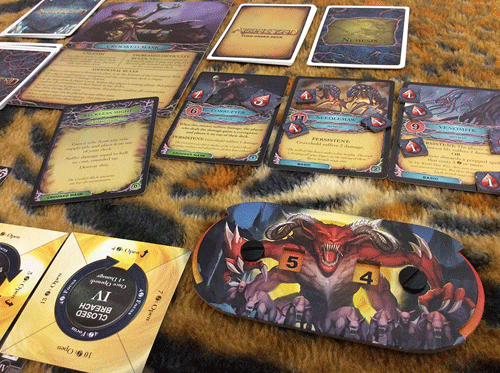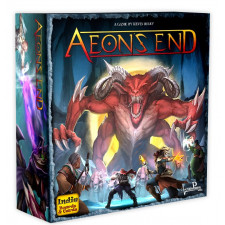Aeon's End Review
on Feb 28, 2017
Aeon's End is a cooperative, deckbuilding card game. After an apocalyptic invasion by interdimensional demons call The Nameless, an order of magical adepts called breach mages have learned to harness the power leaching off of the same dimensional breaches that brought the invaders to The World That Was and use that power to defend the last bastion of humanity, an underground fortress called Gravehold. As breach mages, players construct a deck of empowered gems, spells and relics to fend off an attack by one of the big bads.

The art and flavor text work together to create a unique but fleshed-out atmosphere.
The cooperative deckbuilder subgenre has reached “innovate or die†level of saturation. Luckily, this first-time design by Kevin Riley, published by Action Phase Games (best known for Heroes Wanted), has a gimmick up every sleeve. It can feel more like a bag of sporadically successful tricks than a cohesive design, but the showstoppers make it a welcome addition to the deckbuilding genre.
The first trick: it's a deckbuilding game in which you never shuffle your deck. This is the first line of the rules, to make sure the players know it's kind of a big deal. Like other deckbuilders, you play cards, called gems, as currency to buy bigger and better cards from a Dominion-style fixed offer (as opposed to the more popular Legendary- or Ascension-style conveyor belt), with the newly purchased cards going into your discard pile. Unlike other games, when your deck gets empty, you simply flip your discard over and keep drawing; no more shuffling a 10-card deck every two rounds. Theoretically, this removes one of the genre's greatest annoyances, reduces wear and tear on the cards, and opens up all sorts of fascinating gameplay considerations by giving players responsibility over deck control.
As it turns out, that's only half accurate. It's nice to get away from the constant shuffling, but the strategic ramifications are almost nil. You can’t manipulate your discard directly, and--as it’s a deckbuilder--you spend a significant time with a small deck of mostly identical cards, so being able to "stack your deck" never has the impact it feels like it should. I could count my cards every turn to decide whether to discard crystal-crystal-crystal-spark or crystal-crystal-spark-crystal, but the payoff isn't worth the AP, so I treat this just like any other deckbuilder.
Trick two: instead of a stream of small enemies like every co-op deckbuilder ever, Aeon’s End has the Nemesis, a 70-HP behemoth that will impact the entire game. The three-tiered Nemesis deck is built before the game by shuffling basic Nemesis cards in with Nemesis-specific cards, and the Nemeses also have special abilities and a unique “Unleash†action, referenced by both basic and special cards. Players can win by defeating the Nemesis or simply surviving it.

Each Nemesis is a totally new challenge.
It’s comparable to Sentinels of the Multiverse’s Villains, except there’s more variety in Aeon’s End’s four Nemeses than Sentinels’ core set could dream of. Rageborne, the basic Nemesis, builds up Fury and then Strikes for a random, devastating effect. Carapace Queen hatches an army of small minions that need to be dispatched quickly before her Swarm ability triggers. Crooked Mask, dark god of temptation, seeds the players’ decks with Corruption, cards that grant an immediate benefit for an ominous price. Finally, the Prince of Gluttons devours the mages’ memories, rapidly depleting the supply piles and adding a new loss condition if all supplies get emptied. With the exception of the one-note Rageborne, each Nemesis is a creative reinterpretation of the game that encourages different strategies and setups.
To defeat The Nameless, you need spells, and these work differently than attacks in many deckbuilders. Before you can “cast†a spell for its ability, you must prep it to an open breach. Because turn order is variable (a six-card deck comprising four player cards and two Nemesis cards), there’s a lot of tension as you ready a spell and hope to cast it before the Nemesis’ next horrible effect resolves.
Speaking of turn order, constantly shuffling a six-card deck is a new level of stupid; it’s baffling that a design that removes shuffling from deckbuilding couldn’t think of an alternative way to handle variable turn order.
Aeon’s End gives you plenty to do with your gems besides building your deck. New breaches can be opened (each mage starts with only one, which limits the amount of spells you can cast per turn) or “focused†to hold a spell temporarily. Players can charge up their mage’s powerful special ability. And some Nemesis Powers, timed abilities, can only be averted by spending gems. Aeon’s End keeps the pressure on players to spend their gems on these short-term benefits instead of making long-term deck improvements; this also gives you something to do once you feel your deck has “arrived.â€
Aside from the special power, each breach mage gets a unique starting card and breach layout. While not as game-changing as the Nemeses, each mage has a unique personality that fleshes out the setting of Gravehold. (Granted, a lot of those personalities belong in a high school poetry zine, but they exist.)
Like Heroes Wanted, Aeon’s End can feel gimmicky at times, with a setting that’s more coherent than its mechanics. However, the Nemesis design alone is enough to set it apart in this rapidly growing and frankly addictive subgenre.

 Customer Support
Customer Support  Subscribe
Subscribe 




 Account
Account  Wishlist
Wishlist 

